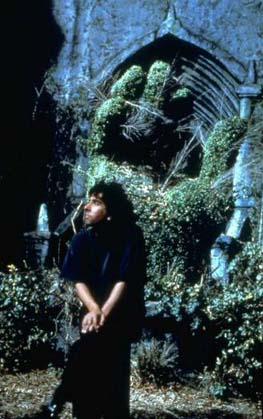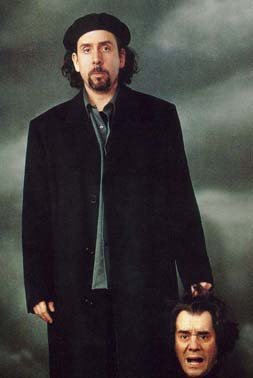BEETLEJUICE BATMAN HAS FANS IN FLA
By Kathleen A. Hughes (The Wall Street Journal)
From The Toronto Star, 12.26.1988, Home Delivery Two
Batman’s sidekick, Robin, is officially dead, but for followers of the dynamic duo everywhere, the worst is yet to come:
The caped crusader may turn out to be a wimp.
Batman’s fans at first were thrilled by reports that Warner Bros. would spend $30 million to make a new Batman movie, for release next summer. They’re no longer thrilled. Warner has cavalierly ignored their advice to cast a serious macho type–Sylvester Stallone or Clint Eastwood, say–in the spectacular. Instead, director Tim Burton has given the part to Michael Keaton.
Michael Keaton is no Sylvester Stallone.
Best known as a wacky prankster in Burton’s 1988 comedy, Beetlejuice, Keaton has a receding hairline and a less-than-heroic chin. He stands an estimated 5 feet 10 inches tall, weighs in at 160 pounds or so, and “looks like a hundred guys you see on the street,” says Beau Smith, a Batman fan in Ceredo, W. Va. “If you saw him in an alley wearing a bat suit, you would laugh, not run in fear. Batman should be 6-2, 235 pounds, your classically handsome guy with an imposing, scary image.”
Not at all, says Burton. “Michael Keaton is basically an ordinary guy, a regular human being,” he says. “I thought it would be much more interesting to take someone like that and make him into Batman. I met with a number of very good, square-jawed actors, but the bottom line was that I just couldn’t see any of them putting on a bat suit.”
This line is less than persuasive to Batman’s fans. Hundreds of passionate and humorless protest letters have poured into the offices of publications that cater to comic-book fans and collectors. Many of the letter writers voice strong suspicion that Warner may pull a fast one, springing on an unwary public a cynical sendup rather than a celebration of Batman.
Warner Bros., a Warner Communications Inc. unit, is “after the money of all the people who only remember Batman as a buffoon with a twerp for a sidekick in the campy TV series from the ’60s,” says J. Alan Bolick, a real-estate appraiser in Suwanee, Ga. “Hollywood is just in it for the money, and Warner Bros. has been doing a bit of duplicity. I don’t think Mr. Burton has any intention of making a serious Batman movie. But Batman has been part of everyone’s childhood. He deserves a bit of respect.”
Fans have circulated petitions demanding a different cast, and they booed Warner representatives who had the audacity to show up at a comics-fan convention with a photograph of Keaton. A few fans also dislike the casting of Jack Nicholson as the Joker, a pathologically evil Batman archenemy. Mr. Nicholson, it seems, is guilty of having a sense of humor.
“How can you have Jack Nicholson playing a villain and not have him be funny,” says David McDonnell, editor of Starlog magazine, a monthly devoted to science-fiction media.
Batman, the fans say, is no joke. They hated the Bam! Pow! tongue-in-cheek TV series from the 1960s, which they think ridiculed their hero and, by extension, his following. By contrast, the absence of Robin, The Boy Wonder, from Warner’s Batman doesn’t ruffle all the fans. In a recent DC Comics telephone poll of fans, a majority voted for a scenario in which Boy Wonder would be blown to bits by a bomb.
Because dyed-in-the-wool fans make up the core audiences for films like Batman, Warner is going to some length to try to appease them–without changing the movie.
Warner executives swear it was never intended to be–and won’t be–a comedy. Warner has sponsored a contest that gives fans a chance to win a role in the film. Studio representatives have touted it in speeches at conventions of comics fans. The studio hired Batman’s comic-strip creator, Bob Kane, as a consultant, and he has been endorsing the movie.
“The movie isn’t a comedy at all. It’s going to be heavy melodrama,” says. Kane. The villainous Joker, he says, “is a psychotic murderer, a maniacal killer. It’s all very evil.”
Warner Bros., which won’t let any of the cast or crew be interviewed directly, also gave the Comics Buyer’s Guide, the fans’ bible, a lengthy statement by the director on why he chose the weak-chinned Keaton.
The fans remain skeptical. “Most people are dismissing Bob Kane, saying Warner is paying him to say nice things about the movie. No one seems to have taken him seriously,” says Don Thompson, co-editor of Comics Buyer’s Guide, which has received more than 500 protest letters to date.
Warner began filming outside London last month. The studio says the fans’ protests have caused no changes in the movie. Some fans also think the protests have been futile.
“There’s been enough whining about Michael Keaton playing Batman,” says James Van Hise, a Poway, Calif., fan and comic-book writer himself. “People are still going on and on about it as though it will make a difference. The one thing a studio will never do is let fans tell them how to make a movie.”
How can a movie about a man who dresses up in a bat costume to fight crime not be funny? What happens in a serious Batman movie, anyway? Warner isn’t blabbing about the plot. But a peek at a recent version of the script shows the demented Joker falling into a vat of toxic waste during a fight with Batman and emerging with a perpetual, ghoulish smile. He takes revenge by tainting soap and shampoo with “Smylenol”, a deadly ingedient that causes users to die laughing. One victim is an anchorwoman who laughs insanely on the air and then keels over with a big grin.
Batman tries to save Gotham City from death by laughter, and he’s particularly interested in saving, a sexy photogapher, played by Kim Bassinger, who . . . But enough. Warner begged us not to give away the ending.
This, then, appears to be a serious movie about people who die laughing. That’s right, says Jeff Walker, a marketing consultant for Warner. “I’ve read all the drafts (of the script) and the only times I laughed were at some of the Joker’s comments,” he says. “Nothing about Batman is a joke.”
Adam West, who played Batman in the TV series, says he had hoped to get the part in the Warner movie. “It’s disappointing not to have the chance to do the definitive, big-screen Batman,” says Mr. West, now 60. While the fans certainly would have disapproved of Mr. West, he thinks his TV rendition of Batman was just right. “Batman isn’t RoboCop or Dirty Harry,” he says. “Batman is a fun character.”
West did once appear in a zany Batman movie made by 20th Century-Fox, after the TV show became a hit. Earlier, in the 1940s, Columbia Pictures released two sort-of-serious Batman serials.
Batman has become grimmer than ever in a series of graphic novels aimed at adults. In Dark Knight, a four-part comic book series set in the future, Batman has retired, Robin is dead, and Gotham City is under attack by a gang called the Mutants, who have killed three nuns and are suspected of stapling a cat to the door of a church.
Now that’s serious. The novels have been big hits in Batman circles.


